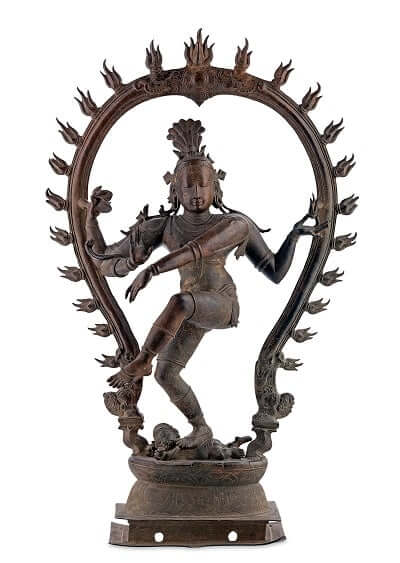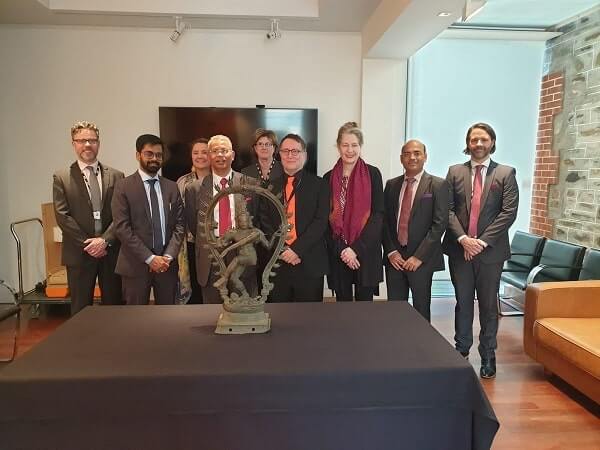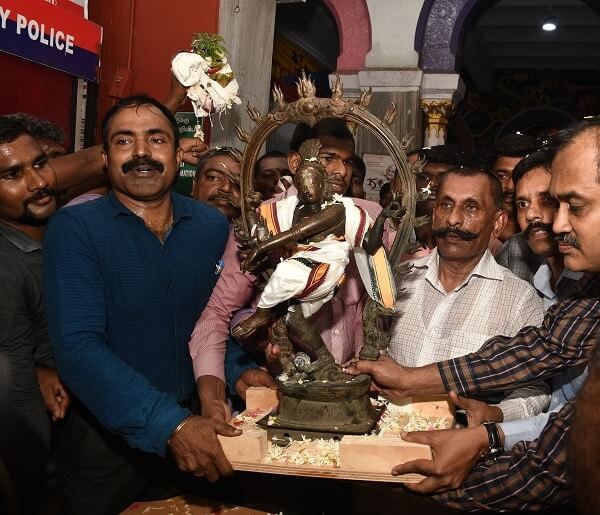Friday the 13th, a date dreaded in the West, turned out to be a very auspicious day for over 25,000 people in the southern Indian village of Kallidaikurichi. Several of them traveled 600 km to Chennai Central to welcome home an old resident, converting the railway station into a temporary temple as they conducted the rituals of puja and aarti.
Returning from Australia, where it sat at the Art Gallery of South Australia (AGSA) in Adelaide, was an ancient statue of the Dancing Shiva(Shiva Nataraja), stolen from their village 37 years ago.

The bronze idol was coming home thanks to the efforts of a special police team in Tamil Nadu and a gracious gesture of the AGSA.
The AGSA, the Dancing Shiva’s temporary home in Australia, is a couple of kilometres away from my home in Adelaide. Its original abode – for some 700 years – is just one kilometre away from my ancestral home in Kallidaikurichi.
Kallidaikurichi, at the foothills of the Western Ranges some 50km north of Kanyakumari, has over a dozen temples large and small. Kulasekaramudayar temple, devoted to Lord Shiva, from where this idol was taken, was possibly built by the powerful Pandyan king of the same name in the 13th century. Being on the outskirts of the village it might have been an easy target for temple raiders, who on June 6, 1982 stole this and three other idols. The local police, having failed to trace the culprits or the lost items, closed the case after two years.
The 76cm tall bronze idol weighing 100kg found its way to the London antiquities dealer Oliver Forge and Brendon Lynch, from whom it was bought in 2001 for the AGSA by then director Ron Radford. The price – a whopping US $255,000.
The Gallery’s current director Rahana Davenport told local Adelaide radio that “the acquisition followed standard protocols accepted as professionally rigorous in that era.”
Following a revelation in 2014 that a larger Dancing Shiva idol at Canberra’s National Gallery of Australia was stolen from another South Indian temple, AGSA revised its Due Diligence Policy and its curator of Asian Art, James Bennett, started provenance research on the idol although there was no reason to believe it had been improperly acquired. (The Canberra idol, bought from the noted artefacts smuggler Subhash Kapoor, was personally handed over to Prime Minister Modi by the then Australian PM Tony Abbott when he visited India).
In 2016 Bennett visited the Pondicherry French Institute that holds archives of Indian antiquities and after checking 6,000 photos found a small image matching the idol in the Adelaide gallery. Next year he visited Kallidaikurichi temple to confirm his finding.
This January, the Government of India requested the return of the idol and the AGSA Board approved its repatriation in April. However, the return was delayed by months thanks to some petty politics in Tamil Nadu. This is one such story where the protagonist commands as much interest as the narrative itself.

Enter Pon Manickavel, a super sleuth who can outclass any Bollywood action hero in busting gangland dons. As an IGP (Inspector General of Police) he was entrusted with the task of retrieval of stolen antiquities in 2012.
With a trademark pointy moustache – a la Capt. Abhinandan of the Indian Air Force – and his unorthodox methods of tackling culprits, he has become a cult figure among the public, while at the same time earning enemies amongst his own ranks. (Such is his repute that a biopic movie of him has already been made).
The day after he retired, the State Government decided to transfer all cases he was working on, to the CBI. On challenging this, the High Court extended his tenure at the Special Idol Wing for a year. He then told a riotous press conference, “I will retrieve the Adelaide idol before my retirement.”
He has lived up to his words.
After a 19-year stay at the gallery, the Dancing Shiva, valued at Rs 30 crores, was handed over to a team of the Archaeological Survey of India in New Delhi by James Bennett and AGSA Registrar Jan Robinson, who graciously paid for the idol’s air transit as the Tamil Nadu Government was dragging its feet. (God is said to move in mysterious ways.)
Lamenting the lack of Government support, Pon Manickavel told the gathering at Chennai Central, “There are over a thousand statues overseas and my mission is to bring back as many as I can before I retire.”
AGSA’s Davenport said, “We are happy to send the idol to its rightful home.”

India’s High Commissioner to Australia, Dr. Gondane, who himself is returning to India soon, said, “This is a very propitious beginning of co-operation between AGSA and the Indian Government which will open new cultural vistas.”
Writer’s note: My thanks to my Indian source Swaminathan who kept me posted on this story for several weeks.
Video Courtesy: Venkat Raman
The AGSA, the Dancing Shiva’s temporary home in Australia, is a couple of kilometres away from my home in Adelaide. Its original abode – for some 700 years – is just one kilometre away from my ancestral home in Kallidaikurichi.


